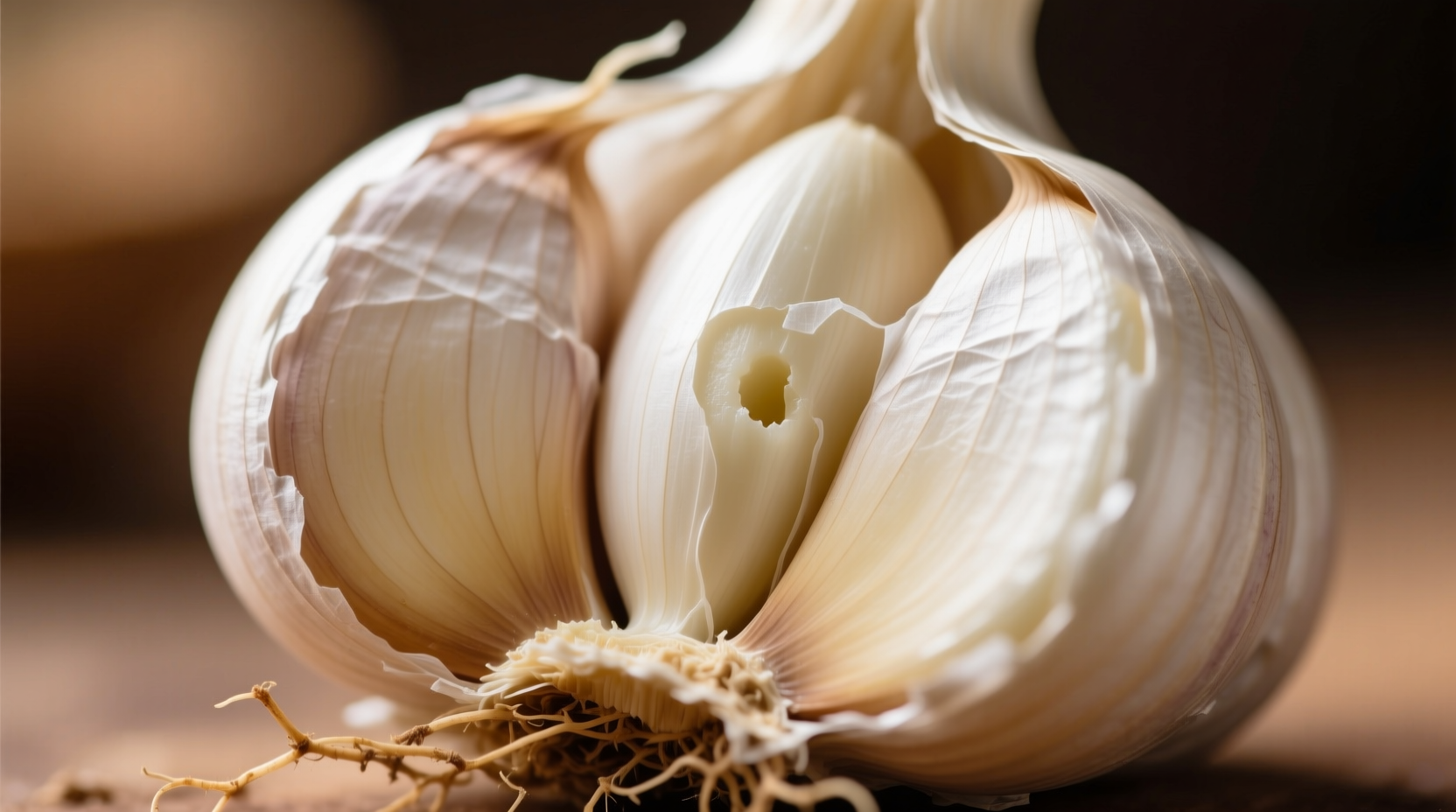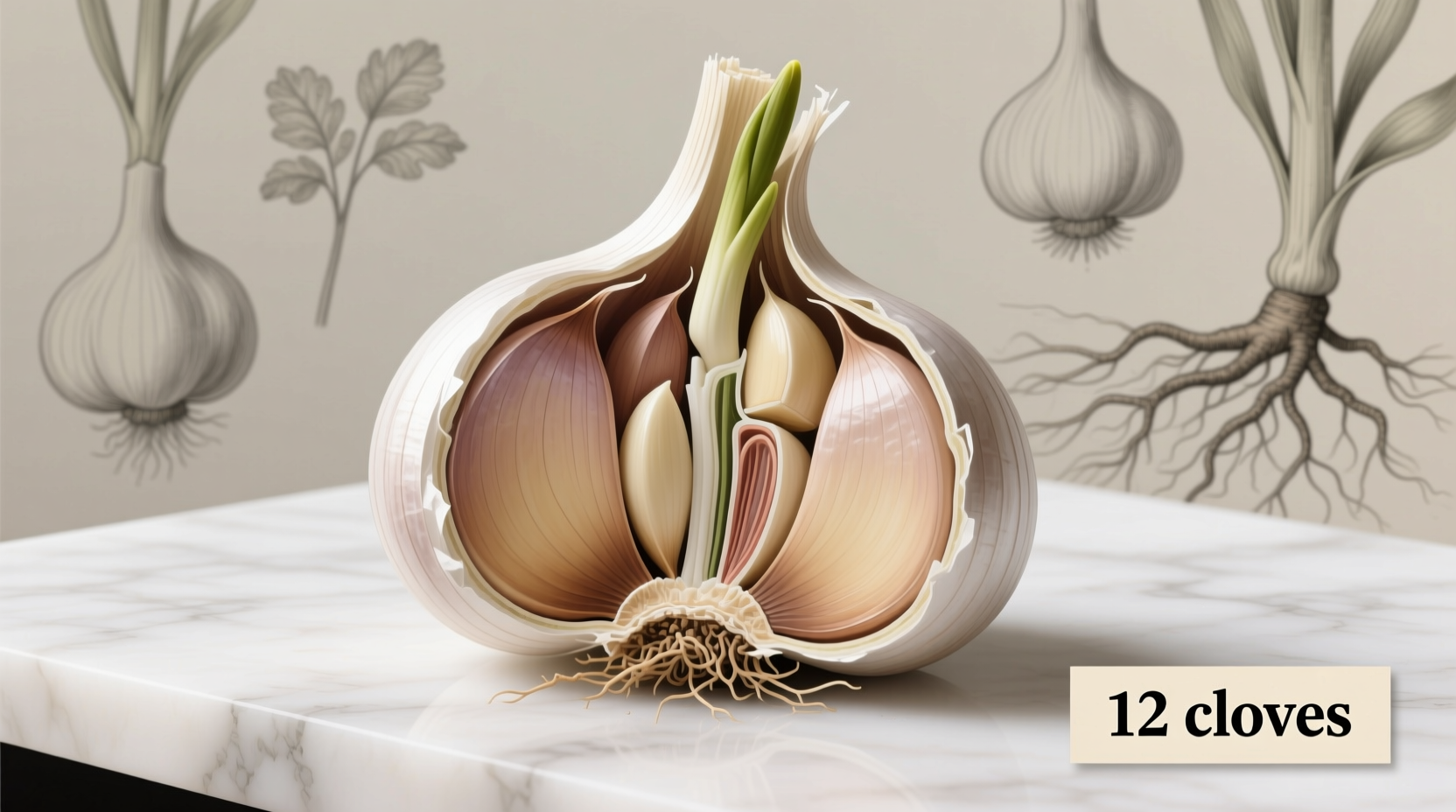Ever stood in your kitchen wondering how many garlic cloves are actually in that bulb you just picked up? Getting this simple measurement right affects recipe success, flavor balance, and meal planning. Whether you're scaling a recipe, meal prepping, or just curious about this kitchen staple, understanding garlic bulb composition saves time and prevents cooking mishaps.
Garlic Bulb Anatomy: What Makes a Clove?
Before counting cloves, it's essential to understand garlic's structure. A garlic bulb (what we commonly call a 'head' of garlic) consists of multiple individual segments called cloves, wrapped in a papery skin. Each clove contains the potent allicin compound responsible for garlic's distinctive flavor and health benefits. The cloves cluster around a central woody stem in hardneck varieties, while softneck types have a more flexible core allowing for tighter clove arrangement.

How Garlic Type Affects Clove Count
The number of cloves varies significantly by garlic variety. Understanding these differences helps set accurate expectations whether you're shopping or cooking:
| Garlic Type | Typical Clove Count | Clove Size | Common Availability |
|---|---|---|---|
| Softneck (Artichoke) | 10-12 | Medium, irregular | Most supermarkets |
| Softneck (Silverskin) | 15-20+ | Small, uniform | Braided garlic displays |
| Hardneck (Rocambole) | 8-12 | Large, easy to peel | Farmers markets, specialty stores |
| Hardneck (Porcelain) | 4-6 | Very large | Seasonal availability |
| Elephant Garlic | 5-6 | Extra large (milder flavor) | Specialty produce sections |
This comparison comes from data collected by the Oregon State University Extension Service, which has documented garlic varieties through agricultural research since 1998. Their studies confirm that softneck varieties dominate commercial production due to longer shelf life, while hardneck types offer more complex flavors preferred by chefs despite lower yields.
Practical Guide to Counting Garlic Cloves
Counting cloves seems straightforward, but these practical tips prevent common mistakes:
- Examine the bulb's circumference - Larger bulbs generally contain more cloves, but size isn't always proportional to count
- Feel for individual segments - Gently squeeze to identify distinct cloves through the outer skin
- Check the basal plate - The flat bottom shows clove arrangement patterns before peeling
- Separate carefully - Start from the outer layer, working inward to avoid missing small inner cloves
- Account for all sizes - Don't overlook tiny cloves often found in the center of softneck varieties
When Precise Clove Count Matters in Cooking
While many recipes simply say "2-3 cloves," certain culinary situations demand precise counting:
- Recipe scaling - When doubling or halving recipes, knowing exact clove count ensures proper flavor balance
- Preservation projects - Pickling or fermenting requires consistent clove sizes for even preservation
- Professional cooking - Chefs maintain flavor consistency across multiple servings
- Dietary restrictions - Those monitoring allicin intake for health reasons need accurate measurements
However, for everyday cooking, approximate counts usually suffice. As noted by the USDA Agricultural Research Service, garlic's flavor compounds vary based on growing conditions, so exact clove count represents just one factor in overall flavor intensity.
Beyond Clove Count: Alternative Measurement Methods
When counting becomes impractical, these reliable alternatives work well:
- Volume measurement - One medium clove ≈ 1½ teaspoons minced garlic
- Weight equivalence - Average clove weighs 3-7 grams (peeled)
- Pre-minced conversion - ½ teaspoon bottled minced garlic ≈ 1 small clove
- Flavor intensity adjustment - Younger garlic (spring harvest) has milder flavor than mature bulbs
These measurements come from standardized culinary testing conducted by the National Institute of Food and Agriculture, which established consistent garlic measurement protocols for recipe standardization across the food industry.
Why Garlic Bulb Composition Has Changed Over Time
Modern garlic varieties differ significantly from historical types due to selective breeding:
- 1950s-1970s - Commercial growers favored softneck varieties for mechanical harvesting and longer storage
- 1980s-1990s - Increased demand for uniform clove size led to standardized supermarket varieties
- 2000s-present - Growing interest in heirloom varieties has revived hardneck types with fewer, larger cloves
This evolution explains why older family recipes might specify "1 large head of garlic" while modern recipes specify exact clove counts—the average bulb composition has shifted toward more consistent sizing.
Practical Tips for Garlic Selection and Storage
Maximize your garlic investment with these professional techniques:
- Selection - Choose firm bulbs without soft spots; tight wrapping indicates freshness
- Storage - Keep in cool, dark place with good air circulation (not the refrigerator)
- Peeling hack - Place cloves in a sealed container and shake vigorously to loosen skins
- Preservation - Freeze peeled cloves in oil for up to 6 months without flavor degradation
FAQ: Common Garlic Questions Answered
How many cloves are in a pound of garlic?
A pound of standard grocery store garlic typically contains 35-50 individual cloves, depending on bulb size and variety. Softneck varieties yield more cloves per pound (45-50) while hardneck types provide fewer (35-40) due to larger individual cloves.
Does the number of cloves affect garlic flavor intensity?
Not directly—flavor intensity depends more on growing conditions and bulb maturity than clove count. However, smaller cloves from the same bulb often have more concentrated flavor than larger outer cloves. The Oregon State University Extension confirms that clove size correlates with moisture content rather than flavor compounds.
Why do some garlic bulbs have tiny cloves in the center?
These small inner cloves, called 'cloves within cloves,' occur naturally in softneck varieties as the bulb develops. They form when the growing conditions cause additional segmentation. While smaller, these cloves have the same flavor profile as larger ones and can be used interchangeably in cooking.
How can I tell if my garlic bulb has more cloves than average?
Examine the bulb's circumference and feel for distinct segments. Bulbs with more cloves typically appear more rounded with less defined segmentation. The basal plate (flat bottom) shows more concentric circles when viewed from below, indicating additional clove layers. Larger diameter bulbs generally contain more cloves than narrower ones of the same variety.
Does organic garlic have different clove counts than conventional?
No significant difference exists in clove count between organic and conventionally grown garlic of the same variety. The University of California's Agricultural Sustainability Institute confirms that farming methods affect bulb size and weight more than clove segmentation patterns, which are genetically determined by the garlic variety itself.











 浙公网安备
33010002000092号
浙公网安备
33010002000092号 浙B2-20120091-4
浙B2-20120091-4